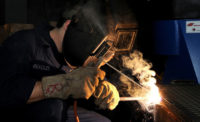An OSHA violation is a serious matter. Many of them can result in injury or death. Some violations are obvious and easy to spot while others require training and a comprehensive understanding of the requirements in order to detect them.
For example, improper Lockout/Tagout of energized equipment or machine guarding, although not simple, might be easier to notice and correct than electrical code violations that require a detailed understanding of the written rules and are likely to be unnoticed by many at the site.
Although most of the people understand basic electricity (e.g., not sticking metal objects into outlets, it is still perceived as a very complicated topic.
However, not all electrical violations are complicated. Some basic OSHA-mandated safety requirements are very easy to spot and correct if one knows what to look for. Among the top ten most frequently cited standards violations for 2014-2015, electrical-related standards violations are number 8 and 10 on the list.
Top 10 Most Frequently Cited Standards violations for Fiscal 2015 (Oct. 1, 2014, to Sept. 30, 2015)
1. Fall Protection (1926.501)
2. Hazard Communication (1910.1200)
3. Scaffolding (1926.451)
4. Respiratory Protection (1910.134)
5. Lockout/Tag Out (1910.147)
6. Powered Industrial Trucks (1910.178)
7. Ladders (1926.1053)
8. Electrical – Wiring Methods (1910.305)
9. Machine Guarding (1910.212)
10. Electrical – General Requirements (1910.303)
Now we are unlikely to be able to educate everyone on everything, but what we can achieve is to give some basic ideas on how these violations can be decreased and potentially save lives. If, as a result of this article, we save one life we could not be happier and it is sad to see people getting injured for something that is so easy to avoid.
So what exactly is so easy to fix? Use a work site GFCI! If you have employees working in a location that has temporary power, it is highly recommended to use a GFCI on every electrical circuit or service, even if there are no OSHA regulations requiring it.
For example , with the use of tools like wet vacs, power washers, wet saws or drills used to mix cement, it is a good practice to have GFCI’s installed to protect employees who work with this equipment. Per OSHA, all construction sites and construction site-like activities that use extension cords or certain equipment have to be GFCI protected2. As a rule of thumb, if you have power equipment outdoors, or near moisture/water you need to use GFCI-protected devices. OSHA estimates that since the GFCI requirement was implemented in 1970, the rule has saved more than 650 lives[1]. That is one person a month since 1970!
What is a GFCI?
GFCI is an electrical device that measures the difference between output and input load current, opening whenever a difference is detected that could pose a safety hazard. If there is a current difference of more than 6 milliamps (mA), the GFCI unit will disconnect power to the load. Don’t be fooled into using a standard circuit breaker. Circuit breakers are designed to protect equipment not people!
GFCI’s come in a variety of forms and shapes, but for MRO or construction industries, the two most common options are right angle plug adapters or corded GFCIs that have a power cord and multiple output sockets. Each type might come with various additional features, especially the corded models. Corded models can offer different cord lengths from 2 ft up to 100 ft long, and also illuminated outlets and various socket configurations.
Something to remember is that socket multipliers and surge protectors are not the same as a GFCI. A GFCI is the only device designed specifically to protect people, whereas everything else is designed to protect equipment from damage due to high voltage transients. This is important to remember in order to choose the appropriate device for its intended application. If you have a device and you want to protect equipment from damaging power transients, then use a surge protector. However, if your primary concern is to protect employees, a GFCI is the only product capable of doing it.
A properly designed and manufactured GFCI unit will continue to provide protection when hazardous wiring conditions present. For example mis-wiring the neutral wire and a hot wire at the circuit breaker or outlet will not impede the GFCI’s ability to offer protection.
There are certain circumstances when a GFCI might not prevent a shock, such as when a person touches both electric wires at the same time, offering a path from one wire in through one hand, through the body, and out on the other hand to the other electric wire. In this situation the GFCI will not sense a current imbalance and will not trip. This is a very important point to consider when training personnel working on equipment with GFCIs.
GFCI’s are intended to trip if current is passing through a path to ground; this could be from a tool or piece of equipment through the user. The GFCI is intended to trip quickly, so the user is not harmed.
It should be noted that a shock can be felt even with a GFCI, but the GFCI will trip quickly enough to avoid an injury.
When looking for a GFCI something to keep in mind is the design of the product. Although there are a lot of products available on the market, the most reliable products carry a UL approval. UL is the leading safety organization with best test and follow up practices. This ensures products are produced with safety critical aspects continually tested and validated in the factory. You might find some products that are few dollars cheaper, but do not carry UL approval and they may perform just as well. The key here is “may”. Products that have UL approval have undergone the most rigorous testing and follow up inspection, and so it should be the “product of choice” when personnel safety is important.
Having several of the GFCI products in your department is just as easy as having many extension cords. GFCI’s become second nature once employees are trained to use them. No one wants to get electrocuted or injured. It is very easy to use them and highly effective in any environment!
2OSHA 1926.404(b)(1(ii)






